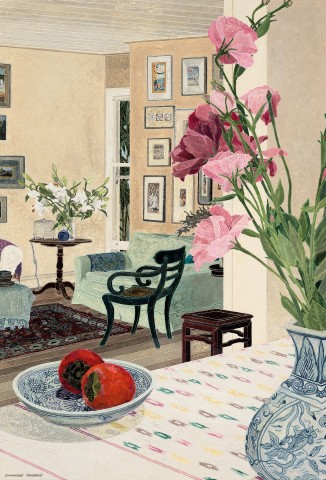BRONTE INTERIOR, 2003
CRESSIDA CAMPBELL
unique colour woodblock print
95.0 x 60.0 cm
signed lower left: Cressida Campbell
also signed below image lower left: Cressida Campbell
Philip Bacon Galleries, Brisbane
Private collection, Queensland
Menzies, Sydney, 23 June 2016, lot 14
Private collection, Queensland
Cressida Campbell Still Life and Interiors, Nevill Keating Tollemache Ltd, London (in association with Philip Bacon Galleries, Brisbane), 3 – 18 July 2003, cat. 26
Crayford, P., (ed.), The Woodblock Painting of Cressida Campbell, Public Pictures Pty Ltd, Sydney, 2010 (3rd ed.), cat. P0306, p. 347
Bronte Interior, 2003, watercolour on incised woodblock, 95.0 x 60.0 cm, private collection, illus. in Crayford, P. (ed.), ibid., pp. 224 – 225
An accomplished artist working at the intersection of painting and printmaking, Cressida Campbell conjures beautiful unique images whose prosaic subject matter conceals their meticulous conception. These works, on paper and on painted woodblock, are testaments to her sophisticated visual intelligence and dedicated commitment to her art. Her humble appreciation for the small wonders around her delights collectors with the knowledge of shared experience. In this masterful woodblock print in soft warm tones, Bronte Interior, Campbell combines several subjects into the deep field of this view of her weatherboard house in Bronte: a still life of ripe pomegranates and delicate pink lisianthus in the foreground, blending into a serene and unoccupied interior, with a tiny sliver of dense bamboo landscape visible through a window frame. It is this oblique, obstructed and multilayered composition that provides Campbell’s interiors with such enduring appeal. With Japanese understanding of pictorial composition, Campbell’s interiors present a believable window into the artist’s rich private world.
During her studies at East Sydney Technical College with Les Matkevich, Campbell discovered and developed a strong affinity with the medium of woodblock printing. But it was in 1980, at the Yoshida Hanga Academy in Tokyo, that she developed her adaptation a technique of monoprinting from hand painted woodblocks, called Yiban Duose (meaning ‘one block, many colour printing’), making it her dominant pictorial mode. Campbell, since the late 80s, has exhibited and sold each painted woodblock alongside its unique print, requiring her compositions to work both in positive and negative. Similar to cloisonné, the chalky watercolour impression on paper features delicate contours each coloured section, a white negative trace of the block’s incised furrows. In spite of her profound respect for observable reality, Campbell’s images are more than faithfully recorded snapshots. These images are constructed and rigorously edited into cropped panels, the intricacies of their design stiches together disparate viewpoints and includes titillating allusions to what lies beyond the frame.
The influence of Japanese art in the aesthetic and technique of Campbell’s artworks is so profound that an entire chapter was devoted to the subject in the monograph accompanying the artist’s recent retrospective exhibition at the National Gallery of Australia. Asian works of art, prints, furniture, ceramics and textiles appear often in Campbell’s artworks, composing a large proportion of the artist’s personal collection and filling the shelves and walls. These objects were acquired from local dealers, during her travels with her first husband Peter Crayford, and through her sister Sally Campbell who collects and deals in Asian textiles. The artist also considers her collection of chairs to be a collection of sculptures, and places them in her compositions ‘because they make for great design’.1 The green chair recently vacated in the visual centre of Bronte Interior, although inanimate, stands in for a human presence, while the bursting vigour of life radiates from natural elements placed strategically in the corners of this composition.
Long before Campbell overtly described this process in the title of a work (Journey Around My Room, 2019), she created images which gently coax viewers to travel through time and space, living vicariously through the artist and her personal recollections, both known and imagined. To collect is to travel, and the artist displays clearly her love for the objects in her collection through her careful attention. She explained this impetus in 1997 ‘things that I love, if I have not made them into a picture, I feel I have not fully experienced them’.2
The long and illustrious history of the genre of Still Life has often been entangled with powerful moral lessons about the emptiness of worldly possessions, and memento mori – the fleeting nature of natural beauty and the transience of earthly life. If these classic codes of iconography inform our contemporary reading of Campbell’s work, this is unintentional. Memorialising opportunistic everyday details from her domestic environment and elevating them to the hallowed surfaces of her compositions, Campbell makes no comment on distinctions between fine art and decoration, simply addressing the things in which she derives an aesthetic pleasure and hoping that others will respond in turn to their seductive impact.
1. The artist in conversation with Rebecca Edwards, in Noordhuis-Fairfax, S., Cressida Campbell, National Gallery of Australia, Canberra, 2022, p. 48
2. The artist, cited in Wright, M., ‘Arts’, Australian Financial Review Magazine, Sydney, 26 September 1997, p. 112
LUCIE REEVES-SMITH
